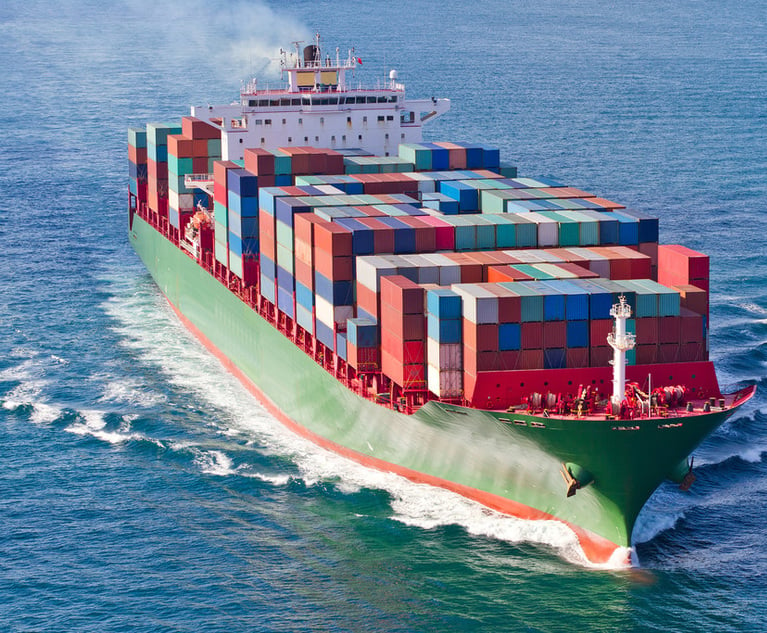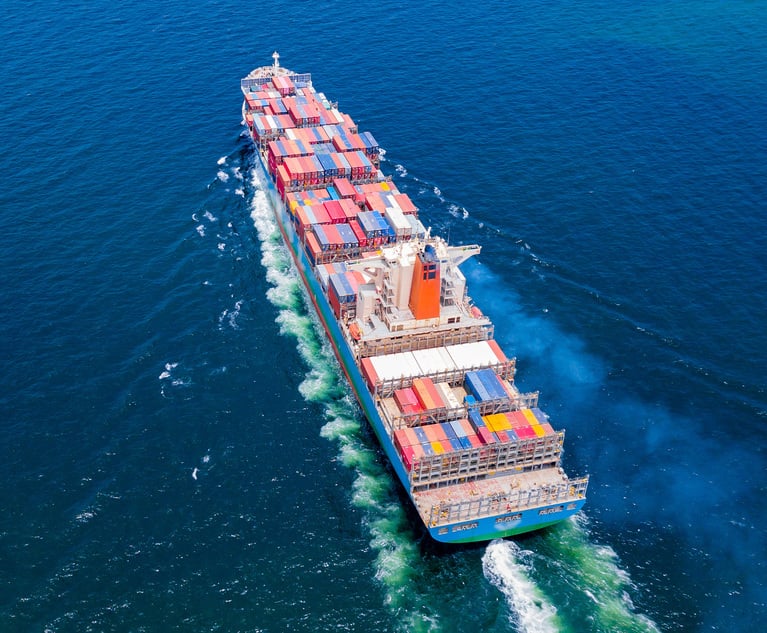 View of the container ships in Newark container terminal, where the gantry cranes are loading and discharging cargo from the vessels, Newark, New Jersey.
View of the container ships in Newark container terminal, where the gantry cranes are loading and discharging cargo from the vessels, Newark, New Jersey. Maritime Law Column: Implications of the EU's Emissions Trading System, Fuel EU Maritime Regulation
On Jan. 1, 2024, a large segment of commercial merchant vessels will be subject to an emissions-cap-and-trade system.
November 27, 2023 at 01:29 PM
5 minute read
Cargo and ShippingOn Jan. 1, 2024, for the first time a large segment of commercial merchant vessels (cargo and certain passenger ships above 5,000 gross tons) will be subject to an emissions-cap-and-trade system. Implemented by the European Union, the Emissions Trading System (ETS), which has been in effect for many years, will now require each vessel trading exclusively within the Euro Zone to pay a tax to cover the CO2 emitted by the vessel. For vessels trading to and from the zone, each will be required to pay a tax covering 50% of such emissions. The tax will be phased in over time (40% of CO2 emissions in 2024; 70% in 2025; and 100% in 2026). In 2026, the ETS will extend to Methane and Nitrous Oxide emissions. As well, the EU has adopted a new Fuel EU Maritime regulation, which will gradually introduce lower GHG-emitting bunker fuel to power vessels with the goal of reducing GHG emissions in bunker fuels by 80% by 2050. The EU's near-term goal is to reduce GHG emissions by 55% by 2030 from 1990 levels.
The mechanism to pay the tax is the EU Allowance (EUA), which are authorizations to emit a certain level of CO2 emissions administrated through a central online database known as the Union Registry run by the European Commission. EUAs are currently available for purchase to maritime stakeholders. The Registry is creating new Maritime Operator Holding Accounts. EUAs may be bought and sold on the market, and sellers may sell them across all regulated industries, including the power sector and aircraft operators. EUAs may be bought in the primary market through auctions on the European Energy Exchange (EEX). EUAs relating to merchant vessels may be surrendered starting in 2025 to compensate for emissions from the previous year. Emission reports are due by March 31 of the following year.
This content has been archived. It is available through our partners, LexisNexis® and Bloomberg Law.
To view this content, please continue to their sites.
Not a Lexis Subscriber?
Subscribe Now
Not a Bloomberg Law Subscriber?
Subscribe Now
NOT FOR REPRINT
© 2025 ALM Global, LLC, All Rights Reserved. Request academic re-use from www.copyright.com. All other uses, submit a request to [email protected]. For more information visit Asset & Logo Licensing.
You Might Like
View All
Maritime Law Column: When Is a Contract Maritime and Why Is That Important?
7 minute read

Maritime Law Column: Texas Maritime Public Infrastructure Projects to Watch
6 minute read
Law Firms Mentioned
Trending Stories
- 1Settlement Allows Spouses of U.S. Citizens to Reopen Removal Proceedings
- 2CFPB Resolves Flurry of Enforcement Actions in Biden's Final Week
- 3Judge Orders SoCal Edison to Preserve Evidence Relating to Los Angeles Wildfires
- 4Legal Community Luminaries Honored at New York State Bar Association’s Annual Meeting
- 5The Week in Data Jan. 21: A Look at Legal Industry Trends by the Numbers
Who Got The Work
J. Brugh Lower of Gibbons has entered an appearance for industrial equipment supplier Devco Corporation in a pending trademark infringement lawsuit. The suit, accusing the defendant of selling knock-off Graco products, was filed Dec. 18 in New Jersey District Court by Rivkin Radler on behalf of Graco Inc. and Graco Minnesota. The case, assigned to U.S. District Judge Zahid N. Quraishi, is 3:24-cv-11294, Graco Inc. et al v. Devco Corporation.
Who Got The Work
Rebecca Maller-Stein and Kent A. Yalowitz of Arnold & Porter Kaye Scholer have entered their appearances for Hanaco Venture Capital and its executives, Lior Prosor and David Frankel, in a pending securities lawsuit. The action, filed on Dec. 24 in New York Southern District Court by Zell, Aron & Co. on behalf of Goldeneye Advisors, accuses the defendants of negligently and fraudulently managing the plaintiff's $1 million investment. The case, assigned to U.S. District Judge Vernon S. Broderick, is 1:24-cv-09918, Goldeneye Advisors, LLC v. Hanaco Venture Capital, Ltd. et al.
Who Got The Work
Attorneys from A&O Shearman has stepped in as defense counsel for Toronto-Dominion Bank and other defendants in a pending securities class action. The suit, filed Dec. 11 in New York Southern District Court by Bleichmar Fonti & Auld, accuses the defendants of concealing the bank's 'pervasive' deficiencies in regards to its compliance with the Bank Secrecy Act and the quality of its anti-money laundering controls. The case, assigned to U.S. District Judge Arun Subramanian, is 1:24-cv-09445, Gonzalez v. The Toronto-Dominion Bank et al.
Who Got The Work
Crown Castle International, a Pennsylvania company providing shared communications infrastructure, has turned to Luke D. Wolf of Gordon Rees Scully Mansukhani to fend off a pending breach-of-contract lawsuit. The court action, filed Nov. 25 in Michigan Eastern District Court by Hooper Hathaway PC on behalf of The Town Residences LLC, accuses Crown Castle of failing to transfer approximately $30,000 in utility payments from T-Mobile in breach of a roof-top lease and assignment agreement. The case, assigned to U.S. District Judge Susan K. Declercq, is 2:24-cv-13131, The Town Residences LLC v. T-Mobile US, Inc. et al.
Who Got The Work
Wilfred P. Coronato and Daniel M. Schwartz of McCarter & English have stepped in as defense counsel to Electrolux Home Products Inc. in a pending product liability lawsuit. The court action, filed Nov. 26 in New York Eastern District Court by Poulos Lopiccolo PC and Nagel Rice LLP on behalf of David Stern, alleges that the defendant's refrigerators’ drawers and shelving repeatedly break and fall apart within months after purchase. The case, assigned to U.S. District Judge Joan M. Azrack, is 2:24-cv-08204, Stern v. Electrolux Home Products, Inc.
Featured Firms
Law Offices of Gary Martin Hays & Associates, P.C.
(470) 294-1674
Law Offices of Mark E. Salomone
(857) 444-6468
Smith & Hassler
(713) 739-1250






